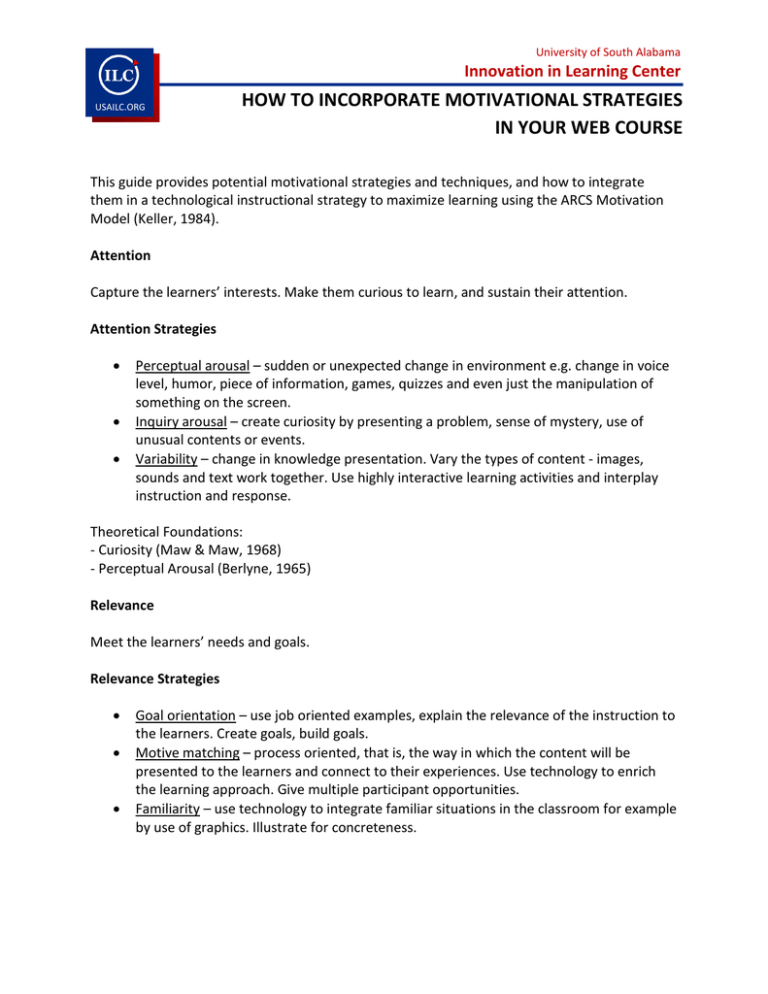HOW TO INCORPORATE MOTIVATIONAL STRATEGIES IN YOUR WEB COURSE
advertisement

University of South Alabama Innovation in Learning Center USAILC.ORG HOW TO INCORPORATE MOTIVATIONAL STRATEGIES IN YOUR WEB COURSE This guide provides potential motivational strategies and techniques, and how to integrate them in a technological instructional strategy to maximize learning using the ARCS Motivation Model (Keller, 1984). Attention Capture the learners’ interests. Make them curious to learn, and sustain their attention. Attention Strategies • • • Perceptual arousal – sudden or unexpected change in environment e.g. change in voice level, humor, piece of information, games, quizzes and even just the manipulation of something on the screen. Inquiry arousal – create curiosity by presenting a problem, sense of mystery, use of unusual contents or events. Variability – change in knowledge presentation. Vary the types of content - images, sounds and text work together. Use highly interactive learning activities and interplay instruction and response. Theoretical Foundations: - Curiosity (Maw & Maw, 1968) - Perceptual Arousal (Berlyne, 1965) Relevance Meet the learners’ needs and goals. Relevance Strategies • • • Goal orientation – use job oriented examples, explain the relevance of the instruction to the learners. Create goals, build goals. Motive matching – process oriented, that is, the way in which the content will be presented to the learners and connect to their experiences. Use technology to enrich the learning approach. Give multiple participant opportunities. Familiarity – use technology to integrate familiar situations in the classroom for example by use of graphics. Illustrate for concreteness. Theoretical Foundations: - Needs Hierarchy (Maslow, 1954; Murray, 1938) - Need for Achievement (McClelland, Atkinson, Clark & Lowell, 1953) Confidence Help the learners believe in success. Confidence strategies • • • Learning requirements – let the learners know what is required of them. Give criteria and feedback, prerequisites, test conditions. Success opportunities – create a challenging but successful atmosphere. From easy to difficult, appropriately difficult level. Vary the difficulty level. Personal control – use techniques that give students a chance to exercise personal control and pace control. Give attributional language. Theoretical Foundations - Self-efficacy (Bandura, 1977) - Learned Helplessness (Seligman, 1975) - Attribution Theories (Weiner, 1974; 1979) Satisfaction Let the learners have success after the instruction. Satisfaction strategies • • • Natural consequences – use technology to provide examples of real life application opportunities i.e. simulated applications. Positive consequences – Appropriate reward and reinforcement schedule. Provide meaningful reinforcement, give optional reward package, reward for correct responses, and give judicious rewards. Equity – Make sure the outcome is consistent to the initial expectations. Exercise and test consistency should be observed and also reward consistency. Theoretical Foundations - Conditioning Theory (Travers, 1977) - Cognitive Evaluation Theory (Deci, 1975) *For further assistance, contact the Innovation in Learning Center at (251) 461-1888. 2 HOW TO INCORPORATE MOTIVATIONAL STRATEGIES IN YOUR WEB COURSE








